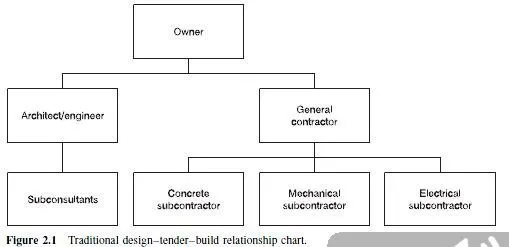We call this approach to construction project delivery traditional because it has been the approach of choice for owners of most construction projects during many centuries. With this method, the owner contracts with a design organisation to perform preliminary planning, carry out design work and prepare contract documents (all of which will be described in some detail in Chapter 3). Following the completion of this phase, a construction organisation is selected, based upon the owners criteria, and the owner enters into a contract with the successful contractor for the assembly of the project elements in the field. In this method, the contract for the design work is separate from that for the construction work. Figure 2.1 shows an organisation chart that might apply to such an arrangement. Note that the owner is under contractual obligation to two parties: the design professional to prepare the design and the general contractor to carry out the field installation. Each of these two parties typically has its own contracts with various subconsultants and subcontractors.
The relationships shown in Figure 2.1 and elsewhere in this chapter are quite simplified. For example, we have not shown any of the subsubcontractors that might be engaged by subcontractors. The mechanical subcontractor might contract with an insulation contractor and an instrumentation contractor for the specialty works that are part of the mechanical subcontract but not within the particular mechanical subcontractors expertise. Furthermore, it is usually the case that subcontractors will contract with various material suppliers, also not shown on our relationship charts.
The various lines connecting the entities in Figure 2.1 and the other figures in this section represent contractual relationships; a contract would be in place between any two parties connected by such lines prior to the commencement of any obligations by either party. It is important to indicate that non-contractual types of relationships may also exist between parties involved in a construction project. For example, the architect/engineer in Figure 2.1 may have some oversight or inspection responsibilities in connection with the general contractors work. Furthermore, despite a lack of contractual relationship between the two parties, the law may permit the contractor or a subcontractor to sue the designer for certain alleged design deficiencies or other acts or conditions that may have impacted the contractors operations. For simplicity, we have not tried to draw such relationships on these charts.
As described above, an important characteristic of the designtenderbuild type of delivery system is that the design and construction organisations are separate. Another especially important feature is that all of the projects design work must be completed prior to solicitation of tenders and no construction work can begin until a successful tenderer has been selected. Thus, the term designtenderbuild implies a strict, and sometimes time-consuming, project schedule sequence designing, followed by tendering, followed by constructing. Future chapters describe these steps in detail.
